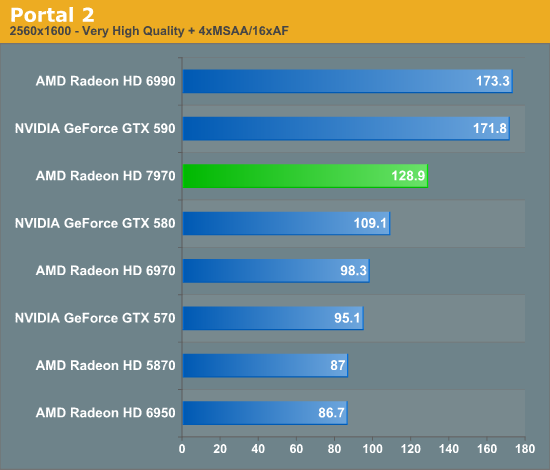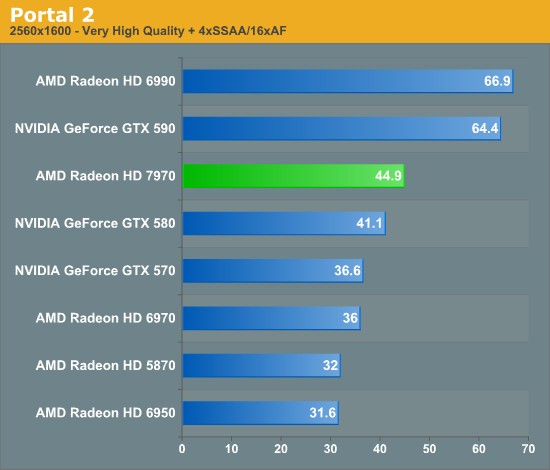AMD Radeon HD 7970 Review: 28nm And Graphics Core Next, Together As One
by Ryan Smith on December 22, 2011 12:00 AM EST- Posted in
- GPUs
- AMD
- Radeon
- ATI
- Radeon HD 7000
Portal 2
Portal 2 continues the long and proud tradition of Valve’s in-house Source engine. While Source continues to be a DX9 engine, Valve has continued to upgrade it over the years to improve its quality, and combined with their choice of style you’d have a hard time telling it’s over 7 years old at this point. Consequently Portal 2’s performance does get rather high on high-end cards, but we have ways of fixing that…


Given Portal 2’s wide range of performance it’s possible to at least somewhat bog it down on the GPU side without any special tricks thanks to its heavier use of shaders than in past Valve titles. Given a fast enough card I believe we could hit the 300fps internal Source framerate cap on our testbed, but thankfully at 2560 we’re nowhere close. In any case at 2560 the 7970 is well into the stratosphere, delivering 128.9fps, which is 18% better than the GTX 580. Meanwhile at 1920 as with so many other benchmarks that lead shrinks, this time down to 11%. Meanwhile the 7970 enjoys a smaller lead over the 6970, beating it by only around 30% at either resolution.


The great thing about the Source engine is that it’s well studied, and by utilizing DirectX9 it’s open to a few more image quality enhancements than DX10+ games. We’ve always wanted to have a standard benchmark with more anti-aliasing than just MSAA, and Portal is the perfect candidate. So for the second part of this test, we’ve turned on Super Sample Anti-Aliasing (SSAA) through NVIDIA and AMD’s driver control panels. With SSAA the entire scene gets anti-aliased, going beyond just removing the jaggies at polygon edges and removing all signs of shader aliasing too, making Portal 2 a very good looking game.
As expected, SSAA makes the performance of everything tank. At 2560 the 7970 is well below 60fps, and every other single-GPU card is slower yet. Once we get down to 1920 performance finally reaches a point where it’s playable, as the 7970 reaches 72.2fps.
Compared to its competition, it’s interesting to note that we appear to have hit an entirely different set of bottlenecks by using SSAA. The 7970 leads the GTX 580 by 9% at both resolutions while it leads the 6970 by 25% under the same conditions. We believe that at this point we’re seeing the limitations of ROP performance, which would explain why the 7970’s lead diminishes versus both the GTX 580 and 6970. The additional bandwidth the 7970’s design affords the ROPs can only go so far until it once again becomes a matter of pixel pushing power.










292 Comments
View All Comments
Wreckage - Thursday, December 22, 2011 - link
That's kind of disappointing.atticus14 - Thursday, December 22, 2011 - link
oh look its that guy that was banned from the forums for being an overboard nvidia zealot.medi01 - Tuesday, January 3, 2012 - link
Maybe he meant "somebody @ anandtech is again pissing on AMDs cookies"?I mean "oh, it's fastest and coolest single GPU card on the market, it is slightly more expensive than competitor's, but it kinda sucks since AMD didn't go "significantly cheaper than nVidia" route" is hard to call unbiased, eh?
Kind of disappointing conclusion, indeed.
ddarko - Thursday, December 22, 2011 - link
To each their own but I think this is undeniable impressive:"Even with the same number of ROPs and a similar theoretical performance limit (29.6 vs 28.16), 7970 is pushing 51% more pixels than 6970 is" and
"it’s clear that AMD’s tessellation efficiency improvements are quite real, and that with Tahiti AMD can deliver much better tessellation performance than Cayman even at virtually the same theoretical triangle throughput rate."
Samus - Thursday, December 22, 2011 - link
I prefer nVidia products, mostly because the games I play (EA/DICE Battlefield-series) are heavily sponsered by nVidia, giving them a developement-edge.That out of the way, nVidia has had their problems just like this card is going to experience. Remember when Fermi came out, it was a performance joke, not because it was slow, but because it used a ridiculous amount of power to do the same thing as an ATI card while costing substantially more.
Fermi wasn't successful until second-generation products were released, most obviously the GTX460 and GT430, reasonably priced cards with quality drivers and low power consumption. But it took over a year for nVidia to release those, and it will take over a year for ATI to make this architecture shine.
kyuu - Thursday, December 22, 2011 - link
Wat? The only thing there might be an issue with is drivers. As far as power consumption goes, this should be better than Cayman.CeriseCogburn - Sunday, March 11, 2012 - link
He's saying the 28mn node will have further power improvements. Take it as an amd compliment - rather you should have.StriderTR - Thursday, December 22, 2011 - link
EA/Dice are just as heavily sponsored by AMD, more in fact. Not sure where your getting your information, but its .. well ... wrong. Nvidia bought the rights to advertize the game with their hardware, AMD is heavily sponsoring BF3 and related material. Example, The Controller.Also, the GTX 580 and HD 6970 perform within a few FPS of each other on BF3. I run dual 6970's, by buddy runs dual 580's, we are almost always within 2 FPS of one and other at any given time.
AMD will have the new architecture "shining" in far under a year. They have been focused on it for a long time already.
Simple bottom line, both Nvidia and AMD make world class cards these days. No matter your preference, you have cards to choose from that will rock any games on the planet for a long time to come.
deaner - Thursday, December 22, 2011 - link
Umm, yea no. Not so much with nvidia and EA/DICE Batttlefield series giving nvidia a development edge. (if it does, the results are yet to be seen)Facts are facts, the 5 series to our current review today, the 7970, do and again continue to edge the Nvidia lines. The AMD Catalyst performance of particular note, BF3, has been far superior.
RussianSensation - Thursday, December 22, 2011 - link
."..most obviously the GTX460 and GT430, reasonably priced cards with quality drivers and low power consumption. But it took over a year for nVidia to release those"GTX470/480 launched March 26, 2010
GTX460 launched July 12, 2010
GT430 launched October 11, 2010
Also, Fermi's performance at launch was not a joke. GTX470 delivered performance between HD5850 and HD5870, priced in the middle. Looking now, GTX480 ~ HD6970. So again, both of those cards did relatively well at the time. Once you consider overclocking of the 470/480, they did extremely well, both easily surprassing the 5870 in performance in overclocked states.
Sure power consumption was high, but that's the nature of the game for highest-end GPUs.